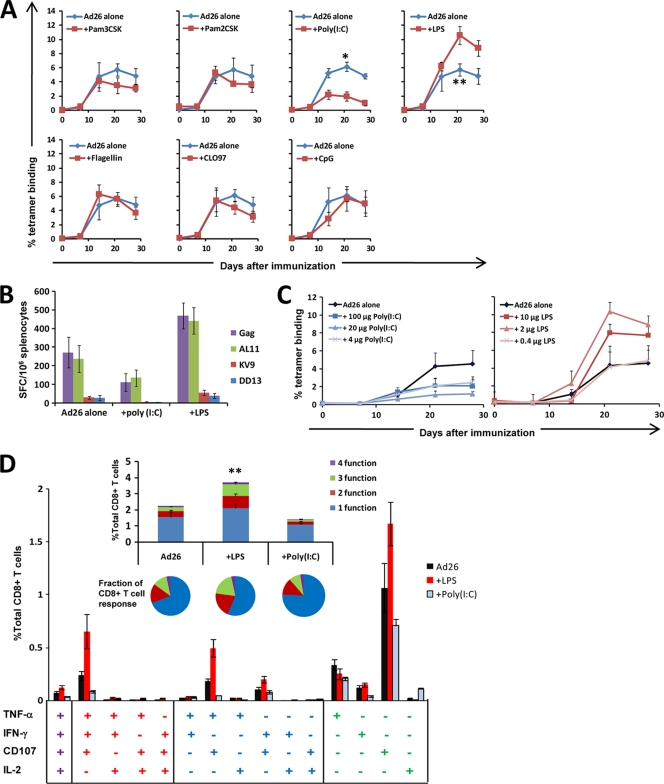FIG. 1.
Antigen-specific CD8+ T cell responses elicited by rAd26-Gag are modulated by soluble TLR ligands. (A) C57BL/6 mice (n = 7 to 8 mice/group) were immunized once with 3 × 108 vp rAd26-Gag alone or 3 × 108 vp rAd26-Gag combined with the following TLR ligands: 20 μg synthetic triacylated lipoprotein (Pam3CSK; TLR1/2 ligand), 20 μg synthetic diacylated lipoprotein (Pam2CSK; TLR 2/6 ligand), 100 μg poly(I:C) (TLR3 ligand), 10 μg LPS (TLR4 ligand), 10 μg flagellin (TLR5 ligand), 100 μg CLO97 (TLR7 ligand), or 40 μg unmethylated CpG-oligodeoxynucleotides (CpG; TLR9 ligand). Gag-specific cellular immune responses were assayed by Db/AL11 tetramer binding assays at multiple time points following injection. (B) At week 4 following immunization, functional immune responses from mice immunized with rAd26 vaccine alone or with 10 μg LPS or 100 μg poly(I:C) were assessed by IFN-γ ELISPOT assays in response to pooled Gag peptides, the CD8+ T lymphocyte epitopes AL11 and KV9, and the CD4+ T lymphocyte epitope DD13. (C) Assessment of the dose response of LPS (10 μg, 2 μg, 0.4 μg) and poly(I:C) (100 μg, 20 μg, 4 μg) with rAd26-Gag (n = 4 mice/group) by Db/AL11 tetramer binding assays. (D) Mice were immunized once i.m. with 3 × 108 vp rAd26-Gag alone, rAd26-Gag with 2 μg LPS, or rAd26-Gag with 20 μg poly(I:C) (n = 4 to 8 mice/group), and Gag-specific CD8+ T cell responses in splenocytes were assessed 4 weeks after vaccination by intracellular cytokine assays for IFN-γ, TNF-α, IL-2, and CD107. Responses to pooled Gag peptides are presented for each individual combination of functions and collated as the number of functions elaborated as a percent of total CD8+ T lymphocytes (insert; bar graph) and as the fraction of Gag-specific CD8+ T lymphocytes (insert; pie charts). Mean responses with standard errors are shown (*, P < 0.001; **, P < 0.05; two-tailed t test).

